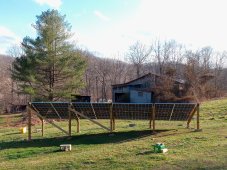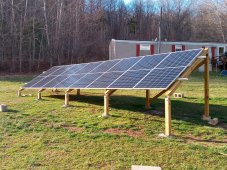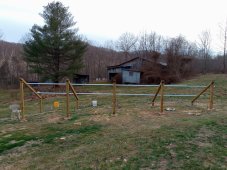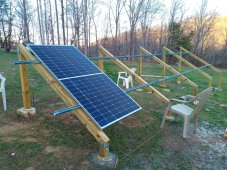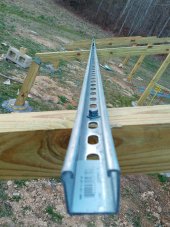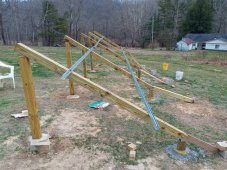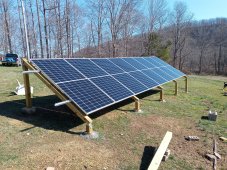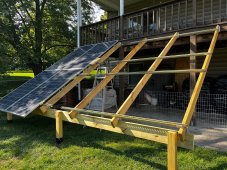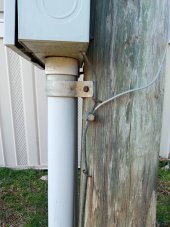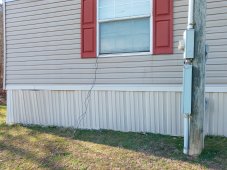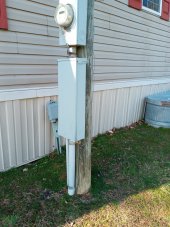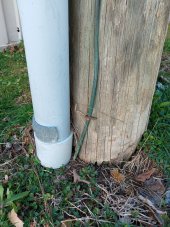Subdood
Photon Wrangler
Hey all, I just finished building a ground mount array with 8 445W bifacials. I used wood for the support structure and unistruts to place the panels on. The struts are galvanized steel and are joined together with a splint plate. There are 3 10ft unistruts joined by the splints, placed in parallel about 45in apart to accommodate the panels.
I took a meter and checked to see if the rails have conductivity by measuring the resistance and they show 0 ohms resistance. I'm assuming the panel frames are anodized aluminum with means they are not conductive. I was planning on joining the panel frames together with some kind of weeb type clamp and copper wire. Plus I would attach the clamps and wire to each rail. BTW, the panels' Isc rating is about 15A at max bifacial power (about 575W) which is unlikely to be reached.
Okay so my questions are these-
1) What gauge wire do I need to use to tie the frames and rails together? I have read it should be 6 gauge, but that 10 gauge is acceptable. I'm guessing it doesn't matter if it's insulated wire like THWN or bare wire? I do plan on stripping away the insulation where it meets the ground clamps. The PV wires and ground wire will meet at a junction box at the array.
2) From the junction box at the array, I am running the PV + and - wires (THWN), which will be 10ga thru conduit (buried 18 inches) about 50ft back to the inverter PV input. The inverter will be mounted in a closet in our house. I was also planning on running the frame ground wire in the conduit. Since this wire will be conduit, does it need to be wire rated for conduit, like THWN, or is bare wire okay? And if I use 6ga ground wire on the frames, does it also need to be 6ga in the conduit?
3) I would like the ground wire to go to the service pole ground rod, which is about 15ft from where the conduit will enter the house. I don't want to run this ground wire back to the inverter in case of lightning strikes. So the question is how do I get this wire to the ground rod if it's in conduit? Could I have like a Y or T junction where the conduit comes up out of the ground at the house where I run the ground in its own conduit to the ground rod?
Sorry for the lengthy question, but I want to make sure I'm doing this right and safely. Thanks. I am enclosing some pics of what the ground mount looked like before and after we put on the panels.
I took a meter and checked to see if the rails have conductivity by measuring the resistance and they show 0 ohms resistance. I'm assuming the panel frames are anodized aluminum with means they are not conductive. I was planning on joining the panel frames together with some kind of weeb type clamp and copper wire. Plus I would attach the clamps and wire to each rail. BTW, the panels' Isc rating is about 15A at max bifacial power (about 575W) which is unlikely to be reached.
Okay so my questions are these-
1) What gauge wire do I need to use to tie the frames and rails together? I have read it should be 6 gauge, but that 10 gauge is acceptable. I'm guessing it doesn't matter if it's insulated wire like THWN or bare wire? I do plan on stripping away the insulation where it meets the ground clamps. The PV wires and ground wire will meet at a junction box at the array.
2) From the junction box at the array, I am running the PV + and - wires (THWN), which will be 10ga thru conduit (buried 18 inches) about 50ft back to the inverter PV input. The inverter will be mounted in a closet in our house. I was also planning on running the frame ground wire in the conduit. Since this wire will be conduit, does it need to be wire rated for conduit, like THWN, or is bare wire okay? And if I use 6ga ground wire on the frames, does it also need to be 6ga in the conduit?
3) I would like the ground wire to go to the service pole ground rod, which is about 15ft from where the conduit will enter the house. I don't want to run this ground wire back to the inverter in case of lightning strikes. So the question is how do I get this wire to the ground rod if it's in conduit? Could I have like a Y or T junction where the conduit comes up out of the ground at the house where I run the ground in its own conduit to the ground rod?
Sorry for the lengthy question, but I want to make sure I'm doing this right and safely. Thanks. I am enclosing some pics of what the ground mount looked like before and after we put on the panels.
Attachments
Last edited:



